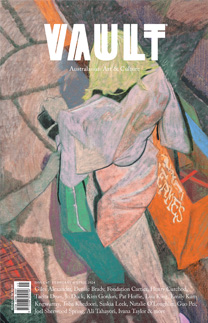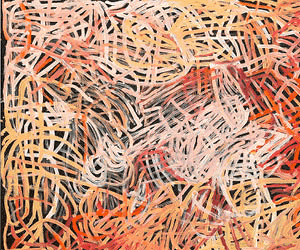Tomás Saraceno: Taking a deep breath
While his famed airborne sculptural installations and spider-web works might tend towards the ethereal, Tomás Saraceno’s foundations in fact-finding and concrete political change run deep, as his works at MONA and QAGOMA reveal.
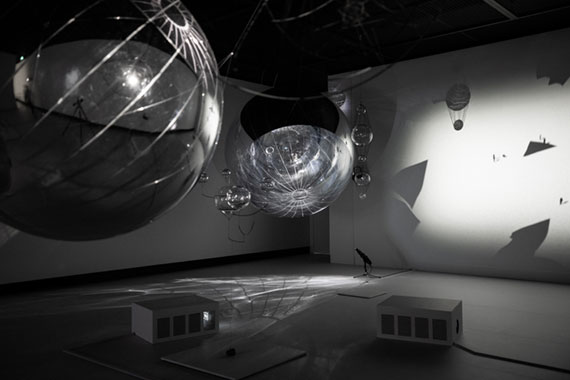
Image credit: Tomás Saraceno, A Thermodynamic Imaginary, 2022 in Oceans of Air, 2022, MONA, Hobart. Photo: MONA/Jesse Hunniford. Courtesy the artist, neugerriemschneider, Berlin and Tanya Bonakdar Gallery, New York / Los Angeles. Image Courtesy Studio Tomás Saraceno and MONA Museum of Old and New Art, Hobart, Australia
Tomás Saraceno’s family brims with scientists, and his botanist mother has collected plants and seeds as far back as her son can remember. “All the time, we go around preserving, collecting and studying,” he says. Saraceno may have turned out to be an artist, but his work is deeply grounded in the rigours of science: research, calibrated trials and evidence-based results. It is no surprise that his studio is like a giant laboratory.
Studio Saraceno in Berlin is a hybrid workshop and office occupying a former company admin building and its neighbouring factory. It takes in this enterprising man’s Arachnophilia Research Laboratory, which sounds scary, and his Aerocene project – think enormous, gorgeous floaty things powered by sun and air. The studio employs designers, architects, anthropologists, biologists, engineers, art historians, curators and musicians. Six of these assistants recently flew to Australia to help install his extensive solo exhibition at MONA, and to mount his centrepiece commission for QAGOMA’s new Air exhibition in Brisbane.
For the works in Oceans of Air at MONA, these helpers have been immensely busy sorting leaves harvested from local trees, including Tasmania’s only Indigenous deciduous tree, Nothofagus gunnii. They also set spiders to work spinning webs, prompted artworks to suspend themselves in the air, and generally ensured Saraceno’s creations were delivered like precious newborns into the world. At the centre of all this activity is the artist himself, an extraordinary man who loves engaging with people. He is a person whose visionary ideas are, at heart, about compassion for this badly-wounded world battling the Capitalocene (a term coined by ecologists who consider it more accurate than Anthropocene).
“We are now facing an urgent general extinction and that is the framework of the exhibition,” Saraceno tells me during a video call from Berlin. He is not, however, wallowing in despair at the state of the global climate: the Argentina-born Saraceno thrives on hope, enterprise and collaboration – especially with First Nations communities – to replace useless hand-wringing with positive action. “There are other ways of knowing,” he says, referring to preliminary discussions he has had with Tasmanian Indigenous Elders about possible projects. He believes that forms of Indigenous knowledge, such as the ecological practice of cultural burning, are filtering through to the general population. But these understandings take time. “Art sometimes can deal with long-term things, rather than needing an immediate response,” he says. “It might take two or three generations to understand what the hell that [Saraceno artwork] was. It’s about behavioural change, like all the activists are saying.”
MONA’s founder-owner David Walsh is a strong supporter of Saraceno and describes the artist’s creations as being so complex they require “a huge multidisciplinary studio to manifest his vision, drawing energy and inspiration from science, nature, architecture, local communities, design, engineering, environmentalism, anthropology, music, history and technology.” Walsh became aware of Saraceno through his daughter’s Argentinian nanny, Patricia, who had praised a work in which the sound of spiders spinning their webs was amplified to basso profundo crescendo. Walsh was moved to post this tale on the MONA website, describing how he had paid little notice to Patricia’s enthusiasm until, a year or so later, MONA curator Olivier Varenne took him to Studio Saraceno. The result of that Berlin visit is one of the biggest shows MONA has staged in years, occupying the three generous spaces on the museum’s lowest level.
In conversation, Saraceno expresses himself in an almost abstract way – overarching ideas and strategies are beautifully articulated, yet it is difficult to discern between what he is speculating about and what might manifest as an artwork. Even curators, despite close contact with Saraceno, find themselves having to be flexible about expectations. Says MONA curator Emma Pike: “You can imagine the vastness of the world he works with and the number of people talking through the ideas. There is always a temptation for a curator to try and lock down a concept, and we do have legitimate deadlines to meet, but that is not always helpful. So, we let the outcomes be loose, as much as we can.”
Saraceno’s output, though, is so stunning that Pike and Varenne, and Geraldine Barlow at QAGOMA, were probably not worried. At the Brisbane gallery, Saraceno’s installation Drift: A cosmic web of thermodynamic rhythms comprises several enormous aero solar spheres constructed with part-reflective and part-transparent materials; they are up to six metres in diameter each and are suspended throughout the soaring central hall of the museum. These objects are a result of Saraceno’s investigations into the possibilities of human flight powered only by sun and air, a massive endeavour continued in his own studio as well as under the auspices of the Aerocene Foundation, a community-based non-profit organisation working on creative enterprises underpinned by evidence-based research. When she visited Studio Saraceno earlier this year, Barlow – already very familiar with the artist’s biosphere sculptures in the QAGOMA collection – became even more convinced a new Saraceno work should be central to Air.
“When I have been thinking about Air, I have been thinking about how we often conceive of air as ‘empty space’ even though it is something we are so dependent upon in the sense that Earth exists within this larger universal space, and it is just gravity holding air around us – this gauzy ethereal thing.” The spheres that comprise Drift, she says, are ever-so-slowly in motion and simultaneously evoke the idea of interplanetary clockwork, the movement of bodily cells and the spinning of particles at a molecular level. “They are quite majestic as they move, while also bouncing refractions of light through the space.”
While almost all Saraceno’s works have some relationship to atmosphere – “We live at the bottom of an ocean of air,” he tells me – the works at MONA include some especially creative results. One work, says Pike, comprises six large panels displaying samples of pollution particles collected by air-testing stations around Australia. These circle-shaped deposits in various colours denote the different times of day the test-strips were collected and the concentration of different pollutants according to location: urban centre samples might be lighter at midnight but darker at peak-hour, while mining centre samples have rustier hues. Pike says the imagery is reminiscent of moon-phase charts.
The work using Tasmanian leaf samples also deals with human impacts, referencing the effects of fire and other factors on the chemical composition of plants. Then, of course, there is Saraceno’s interspecies collaboration with spiders. “People used to talk about Tomás’ ‘spider labs’ but when I spoke to him about it, he said it is more about bringing a spider inside for a while and then returning it to where it lives. They are literally responding to the situation they are put in and spinning webs the way they want to.”
She observes that Saraceno often catches himself trying to make some sort of definitive, science-based statement about his endeavours and lock onto something solid. “Then he quickly moves through that and lets it dissipate and fall back into the chaos of art-making and the conceptual.” While his work is obviously intensely political in its foundations, she says it is not harshly so in the end product, which gently invites people to approach an environmental issue. “It is like a hug.”
Air is at QAGOMA until April 23, 2023 and Oceans of Air is at MONA until July 24, 2023.
mona.net.au
qagoma.qld.gov.au
studiotomassaraceno.org
Tomás Saraceno is represented by Andersen’s, Copenhagen; Tanya Bonakdar, New York; Pinksummer Contemporary Art, Genoa; Ruth Benzacar Galería de Arte, Buenos Aires; and Neugerriemschneider, Berlin.
tanyabonakdargallery.com
andersen-s.dk
pinksummer.com
ruthbenzacar.com
neugerriemschneider.com
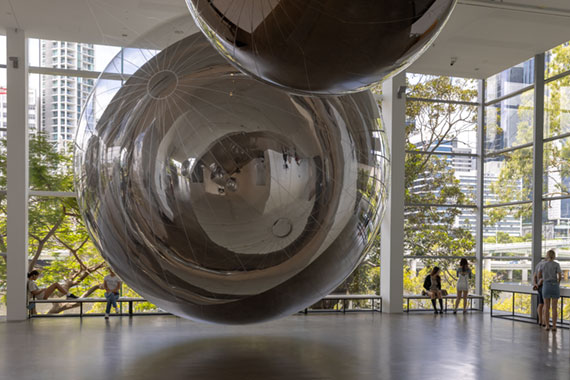
Image credit: Tomás Saraceno,
Installation view Drift: A cosmic web of thermodynamic rhythms, 2015-22 in Air, 2022.
QAGOMA, Brisbane
Aerocene spheres, transparent and metallic mylar, tape, pump with overpressure release, polyester rope, kinetic system, backpack, newspaper, pamphlets, books and photographic prints on paper.
Purchased 2022 with funds from the Neilson Foundation through the Queensland Art Gallery | Gallery of Modern Art Foundation.
Courtesy QAGOMA / © Tomás Saraceno
Photo: Dario Lagana, Studio Tomás Saraceno
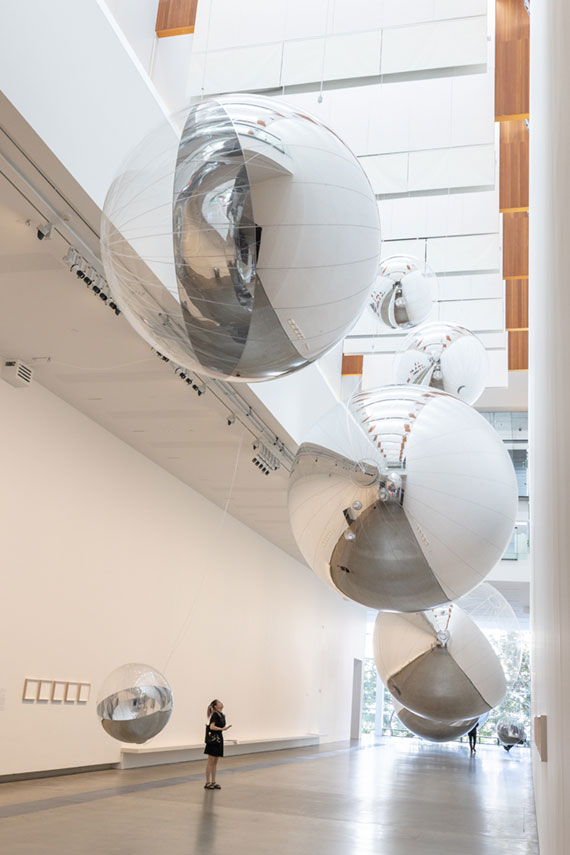
Image credit: Tomás Saraceno,
Installation view Drift: A cosmic web of thermodynamic rhythms, 2015-22 in Air, 2022.
QAGOMA, Brisbane
Aerocene spheres, transparent and metallic mylar, tape, pump with overpressure release, polyester rope, kinetic system, backpack, newspaper, pamphlets, books and photographic prints on paper.
Purchased 2022 with funds from the Neilson Foundation through the Queensland Art Gallery | Gallery of Modern Art Foundation.
Courtesy QAGOMA / © Tomás Saraceno
Photo: Dario Lagana, Studio Tomás Saraceno
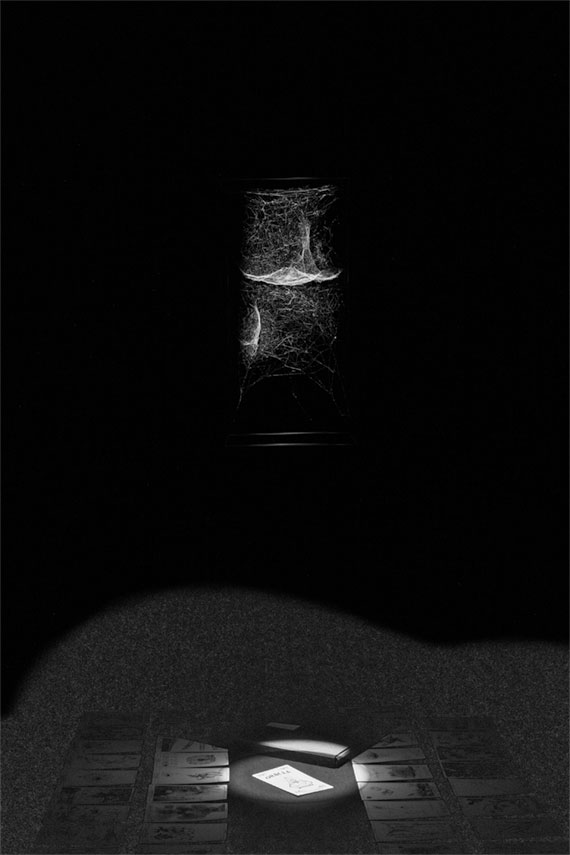
Image credit: Arachnomancy, 2018–ongoing in Oceans of Air, 2022, MONA, Hobart. Photo: Tomás Saraceno. Courtesy the artist, with thanks to Arachnophilia, Andersen’s, Copenhagen; Ruth Benzacar, Buenos Aires, Tanya Bonakdar Gallery, New York / Los Angeles, Pinksummer Contemporary Art, Genoa, neugerriemschneider, Berlin. Image courtesy Studio Tomás Saraceno and MONA Museum of Old and New Art, Hobart, Australia
This article was originally published in VAULT Magazine Issue 41 (Feb – Apr).
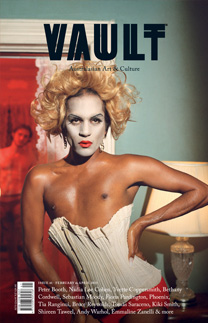
Click here to Subscribe







